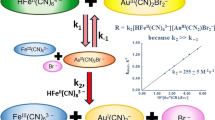Summary
-
1.
The reaction of lithium hydride with boron trifluoride etherate has a complex mechanism, which probably includes various parallel and successive reactions leading to the formation, as the ultimate boron-containing products, of diborane, lithium borohydride, and lithium fluoborate. The yield of diborane is dependent on reaction temperature, relative amounts of reactants, degree of agitation of the reaction mixture, and order of addition of reactants.
-
2.
An almost quantitative yield with respect to both reactants is attained by carrying out the reaction at somewhat raised temperature (25–30°) in the initial stage, at a BF3 : LiH ratio of 1 : 2,4–2.8, and with gradual addition under constant stirring of lithium trifluoride etherate to lithium hydride.
-
3.
The reaction studied is the simplest and most economical method for the preparation of highly pure diborane under laboratory conditions, and it opens up wide possibilities for the further study of the chemistry of boron hydrides and their derivatives.
Similar content being viewed by others
Literature cited
A. Stock and K. Freiderici, Ber. 46, 1959 (1913).
A. Stock and K. Friederici and O. Preiss, Ber. 46, 3353 (1913).
A. Stock and E. Kuss, Ber. 56, 789 (1923).
A. Stock, Hydrides of Boron and Silicon (N. Y., 1933).
W. J. Schlesinger and A. Burg, J. Am. Chem. Soc. 53, 4321 (1931).
A. Stock and W. Sutterlin, Ber. 67, 407 (1934).
D. Hurd, J. Am. Chem. Soc. 71, 20 (1949).
A. F. Finholt, A. C. Burg, and H. J. Schlesinger, J. Am. Chem. Soc. 69, 1199 (1947).
U. S. Patent 2644472, Offic. Gaz. U. S. Pat. Office 6/III, 644, No. 1, 259, (1951); C. A. 4511 (1951).
U. S. Patent 2543511, Offic. Gaz. U. S. Pat. Office 27/IV, 643, No. 4, 1272 (1951); C. A. 4510 (1951).
J. Schapiro, H J. Weiss and M. Schmith, J. Am. Chem. Soc. 74, 901 (1952).
J. R. Elliott, E. M. Boldebuck and G. F. Roedel, J. Am. Chem. Soc. 74, 5047 (1952).
J. R. Elliott, J. Am. Chem. Soc. 74, 5211 (1952).
H. J. Schlesinger, H. C. Brown, J. R. Gilbreath and J. J. Katz, J. Am, Chem. Soc. 75, 195 (1953).
Inorganic Syntheses 1, 21 (1939).
V. I. Mikheeva and E. M. Fedneva, Proc. Acad. Sci. USSR 101, 99 (1955).
I, G. Ryss, J. Gen. Chem. 16, 531 (1946).
A. Stock and E. Kuss, Ber. 47, 810 (1914).
V. I. Mikheeva and V. Yu. Surs, Proc. Acad. Sci. USSR 93, 67 (1953).
H. C. Brown, H. J. Schlesinger and S. Z. Cardon, J. Am. Chem. Soc. 64, 325 (1942).
Author information
Authors and Affiliations
Rights and permissions
About this article
Cite this article
Mikheeva, V.I., Fedneva, E.M. Reaction between the ether complex of boron trifluoride and lithium hydride Communication 1. Preparation of pure diborane. Russ Chem Bull 5, 925–934 (1956). https://doi.org/10.1007/BF01166405
Received:
Issue Date:
DOI: https://doi.org/10.1007/BF01166405




